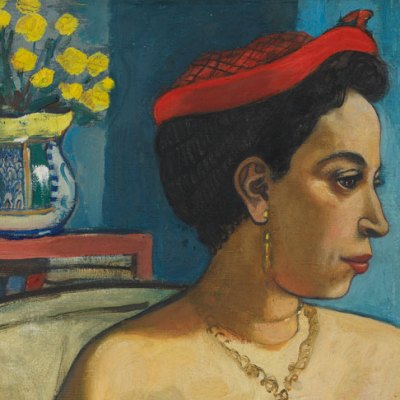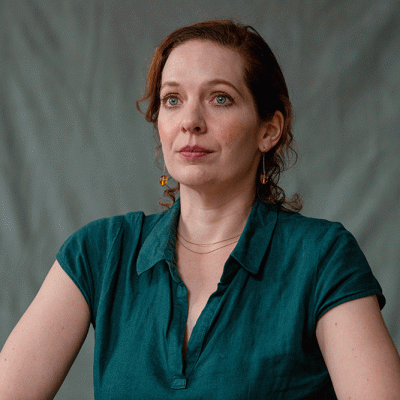From the April 2021 issue of Apollo. Preview and subscribe here.
If you’re looking for the opposite of social distancing – and who isn’t, these days? – then Alice Neel is there for you. There, that is, at the Metropolitan Museum of Art, which has recently opened a full-scale survey of this greatest of 20th-century portraitists (‘Alice Neel: People Come First’; until 1 August). Go if you can, and revel in the sheer presence of so many unmasked faces, so many interesting humans – the encounter with each one unforgettable.
The timing of the show could not be better. Newly decamped from the Breuer building on Madison Avenue, and finally emerging from months of reduced visitation, the Met – again, like all of us – could use a shot in the arm. Neel most definitely provides it. Over the course of her long career, she was wildly out of step with prevailing tendencies. Only now are we finally catching up to her, at last able to see her paintings as the bracingly essential works that they always have been. Strange to say, she is a painter more of our moment than her own.
Nancy and Olivia (1967), Alice Neel. Collection of Diane and David Goldsmith. © The Estate of Alice Neel
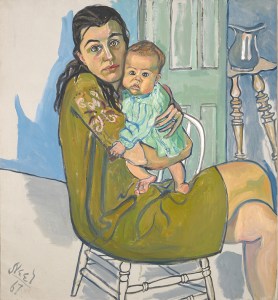
The waywardness began early. The Met’s exhibition catalogue includes a photograph of an art class at the Philadelphia School of Design for Women (now Moore College of Art and Design), where Neel studied in the early 1920s. It shows a dozen smock-clad artists at their easels, gathered around a model in quasi-classical garb. We can see their various paintings, all quite academic, all more or less interchangeable, but for the angle of view.
Neel was having none of that. After gravitating briefly to the work of Robert Henri (he had earlier taught at the school, and his residual influence was the most adventurous on offer), she developed a more simplified faux naïf manner, somewhat akin to contemporaneous European Expressionism. Through the 1920 and ’30s, her eventful life brought her first to Cuba, where she moved with her husband, the painter Carlos Enríquez; then to the Upper West Side and the Bronx, where she lost a daughter in infancy; then, after Enríquez absconded, taking their second daughter, Isabetta, with him, to Greenwich Village and later to Harlem.
She captured this tumultuous period in her work, all the while developing her recognisable idiom: sketchy background, definite contours, strong modelling, psychological penetration. It was a formula of sorts, a little bit Van Gogh, a little bit Matisse, maybe some Munch, but mainly her own invention. Once Neel perfected it, she applied it to everyone she painted, to reliably devastating effect.
By the late 1940s, her work had fully matured. But its raw power – which now seems so self-evident – was all but invisible to her peers. In New York City’s post-war avant garde, swept up in the fervour of Abstract Expressionism, to be a figurative painter was all but disqualifying; being a woman and portraitist, triply so. Neel remained impressively unconcerned about this, painting at such a furious rate and with so little commercial success that her finished canvases were eventually stacked four or five deep against her apartment walls.
Hartley on the Rocking Horse (1943), Alice Neel. Private collection. © The Estate of Alice Neel

Meanwhile, she totally refused to countenance conformist ideals of femininity, in her work or her life. Her fraught family relationships have been much discussed – probably overmuch, as few male artists have been subjected to similar scrutiny for their performance as parents. Having said this, Neel’s complicated feelings about being a mother and a homemaker are an important theme in her work, in ways both haunting – as in her picture of her two-year-old son Hartley, frightened and adrift on a rocking horse – and comical, as when she stopped preparing Thanksgiving dinner so that she could paint the turkey in the kitchen sink.
Thanksgiving (1965), Alice Neel. The Brand Family Collection © The Estate of Alice Neel
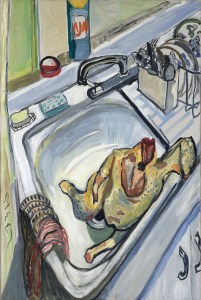
Two Girls, Spanish Harlem (1959), Alice Neel. Museum of Fine Arts, Boston. © The Estate of Alice Neel
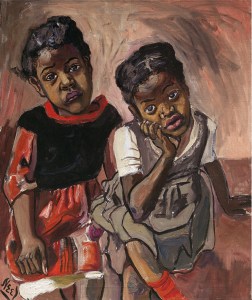
Nor did Neel bend one single degree to anyone else’s idea of how she ought to paint. She did respond to the work of her peers, but entirely on her own terms. The art historian Julia Bryan-Wilson, in her essay for the Met’s exhibition catalogue, recounts Neel’s response to modernist abstraction: in essence, she viewed it as inhumane and bloodless, yet still absorbed its lessons, saying, ‘I don’t think there is any great painting that doesn’t have good abstract qualities.’ True to her word, Neel wilfully departed from naturalism when it suited her, delineating her sitters in vivid blue contours, and treating her backgrounds as zones of free pictorial play, as in Two Girls, Spanish Harlem (1959).
Bryan-Wilson suggests that Neel could be placed, along with such figures as Hilma af Klint and Romare Bearden, in ‘a lineage of minoritized women and artists of color in the twentieth century who seized on abstracting as a critical and political process’. This fascinating argument is in keeping with the general approach of the Met’s project, which retrospectively bestows a broad context to Neel’s work, rather than treating her as an individualistic outlier. One of the exhibition’s two lead curators, Kelly Baum, focuses in her catalogue essay on the artist’s political commitments, illuminating Neel’s relationships with the Communist Party in the 1930s, the civil rights movement of the 1950s and ’60s, and feminism in the 1970s. Throughout, Baum argues, she remained a ‘radical humanist’, her works charged with ethical concern. This quality can be seen in her early cityscapes, which somewhat recall the paintings of her British contemporary L.S. Lowry. (John Berger memorably wrote that Lowry painted people as ‘fellow-travellers through a life which is impervious to most of their choices’, a phrase that applies equally well to Neel’s anonymous working-class figures.)
Ninth Avenue El (1935), Alice Neel. Cheim and Read, New York; © The Estate of Alice Neel
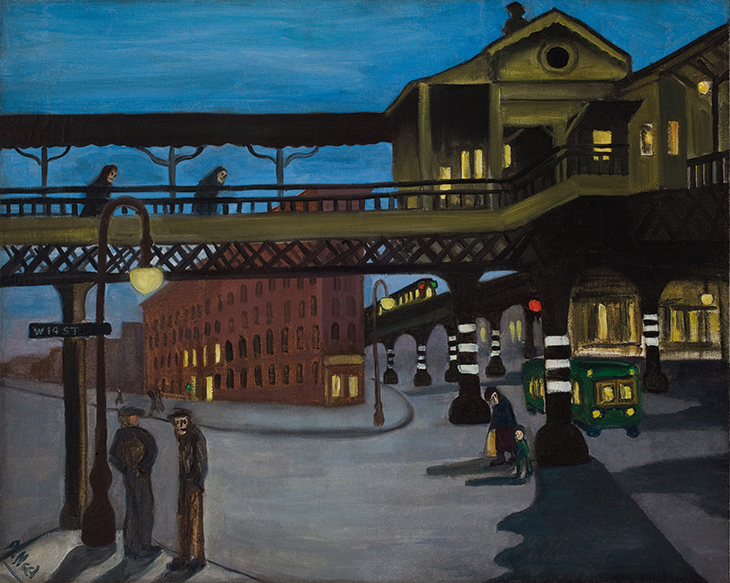
It can be seen, more remarkably, in the great pageant of portraits that she made while living in Spanish Harlem, from 1938 to 1962. She constantly painted the neighbourhood and its citizens: the fish market and the street corner, local kids, neighbours Black and white and Latino and South Asian. Author Alice Childress. Community activist Mercedes Arroyo. James Farmer, co-founder of CORE (the Congress of Racial Equality). It’s hard to think of any other artist, before or since, who painted such diversity. She did it beautifully, too, taking on the technical challenge of rendering different skin tones, and portraying ethnicities without caricature or stereotype. Her paintings of Georgie Arce, a local Latino boy whom she adopted as a subject, show how subtle she could be. Even when he wields a knife, she captures his vulnerability, while respecting his boundaries: she never took from a sitter more than she was given.
James Farmer (1964), Alice Neel. National Portrait Gallery, Smithsonian Institution, Washington, D.C. © The Estate of Alice Neel
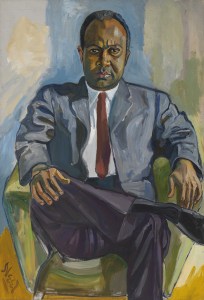
Georgie Arce No. 2 (1955), Alice Neel. Collection of Lonti Ebers. © The Estate of Alice Neel
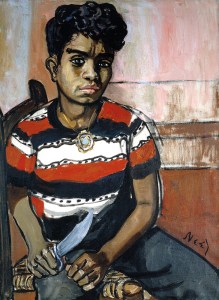
This aspect of Neel’s work positions her as an unlikely forerunner to the generation of Black figurative painters currently ascendant in the art world, such as Jordan Casteel, Jennifer Packer and Amy Sherald. In her own lifetime, though, her paintings of Black and brown people certainly did nothing to improve her reputation. Even when she was ‘discovered’ in the 1970s, her portraits of the Harlem community tended to be marginalised within her oeuvre. That changed only in 2017, with ‘Alice Neel, Uptown’, a potent exhibition curated by the writer Hilton Als at David Zwirner, New York, which put Neel’s handling of racial difference centre stage. Did Neel think Black lives matter? You bet. She also saw people for who they were, not as stand-ins for one demographic or other. ‘She did not treat colored people as an ideological cause,’ Als writes, ‘but as a point of interest in the life she was leading.’ In America, sad to say, this has been a rare enough attitude that her work amounts to a badly needed civics lesson.
Perhaps inevitably, there were limits to Neel’s prescient acceptance. In his essay for the Met’s exhibition catalogue, co-curator Randall Griffey parses the artist’s numerous representations of queer sitters. The good news is that she seems to have been entirely comfortable with gay men. Witness her affectionate portraits of male couples such as David Bourdon and Gregory Battcock; or Jackie Curtis and Ritta Redd (1970), which depicts one of Warhol’s superstars glammed up in drag, attended by a male friend; or her well-known portrait of Warhol himself, in 1970, bearing the scars of his gunshot surgery, nipples soft and pink, narrow shoe-clad feet pointed downward like a ballerina’s. These pictures attest to Neel’s sophisticated understanding of gay male identity and its various encodings; while alluding to prevalent stereotypes, she never traded in them.
Andy Warhol (1970), Alice Neel. Whitney Museum of American Art, New York © The Estate of Alice Neel

When it came to lesbians, however, Neel seems to have had what we might call ‘issues’. She once claimed, in her loose-talking way, to have moved uptown from Greenwich Village ‘because so many lesbians walked up and down the block’. Griffey offers a persuasive reading of Neel’s portrait from 1977 of the art historian Mary Garrard, who is on record as having been made uncomfortable by Neel’s confrontational manner about her sexuality. Garrard sits folded in the artist’s striped chair, fingers tightly laced in front of her to form a little barrier. Still wearing her outdoor coat, hat and scarf, she looks like she can’t wait to get out of there.
Neel had a similarly complex, jousting relationship to the concept of feminism. Historians and critics associated with the women’s liberation movement played a key role in elevating awareness of Neel’s work, and in return, she painted some of its leading lights. Yet, like many other accomplished female artists, such as Lee Krasner and Joan Mitchell, she had no interest in mounting the barricades. Neel did not want to be a standard-bearer for her gender; she didn’t deny the reality of systemic sexism, but she didn’t dwell on it either: ‘It’s an obvious fact that women were second-class citizens,’ she said in 1983, ‘but you didn’t have to be that. I fought that, but in a subterranean way.’
Jackie Curtis and Ritta Redd (1970), Alice Neel. Cleveland Museum of Art. © The Estate of Alice Neel
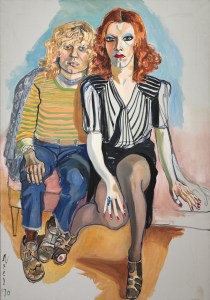
Margaret Evans Pregnant (1978), Alice Neel. Institute of Contemporary Art, Boston. © The Estate of Alice Neel

Her many empowering images of women cut on the bias, characteristically, focusing primarily on the theme of motherhood, which, as Baum notes, ‘was never held in especially high regard by feminists, who mostly considered it a problem to solve’. Her portrait of Linda Nochlin, the lioness of feminist art historians, presents her as a mild-mannered mom, hand slipped around her daughter’s waist in a touching gesture of love and protection. More striking still are the images that Neel made of pregnant women, most shown in the nude. These pictures ‘insist on pregnancy’s stubborn facticity,’ Baum writes, ‘consistently depicting real mothers, not myths, allegories, stereotypes, or political slogans’.
To her infinite credit, Neel did not spare herself from her own unflinching gaze. The capstone to her career is an astonishing self-portrait showing the artist in her birthday suit, at the age of 80. When I first saw this painting in person, on the last wall of the Whitechapel Gallery’s Neel retrospective in 2010, I laughed out loud at its audaciousness. But I sobered up fast, chastened by Neel’s all-conquering clarity. She is seated in the familiar white-and-blue striped chair that plays a supporting role in so many of her pictures, and holds the tools of her trade, brush and rag. She peers out through gold-framed spectacles – a lifetime full of looking, all focused intently on you. The sagging sacks of her breasts and belly are painted with an utter lack of self-consciousness, yet total self-possession. And then there is that priceless, worldly-wise frown, sandwiched between ruddy pink cheeks and shadowed with a Cézanne-ish patch of green. It’s an expression that bears out Hilton Als’ beautiful description of the artist as ‘marked, wounded, by her own sharp intelligence’. The self-portrait operates like a retrospective manifesto, the ultimate proof of her willingness to bare it all.
Self-Portrait (1980), Alice Neel. National Portrait Gallery, Smithsonian Institution, Washington, D.C. © The Estate of Alice Neel

‘Stubborn facticity’, Baum’s phrase, gets it exactly right: Neel may have had a few blind spots, but what she did see, she put down whole and unvarnished. Hence the fierce urgency of the Metropolitan Museum’s show. Recently, Americans have been forced to take a good hard look at themselves, and we may not have liked what we’ve seen. We may well feel lost in recrimination and sorrow. Neel’s paintings reach forward from an earlier time, and give us a good hard slap. This, she seems to say, is how we should see one another. And how hard can it be? She managed it time after time, with people of all walks of life, receiving precious little encouragement beyond the evidence of what she saw in front of her on the canvas. For Alice Neel, thank God, that was more than enough.
‘Alice Neel: People Come First’ is at the Metropolitan Museum of Art, New York, until 1 August.
From the April 2021 issue of Apollo. Preview and subscribe here.
